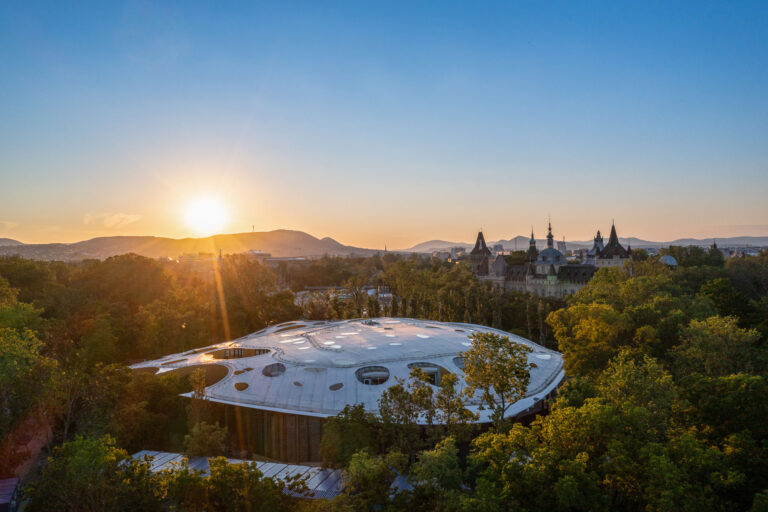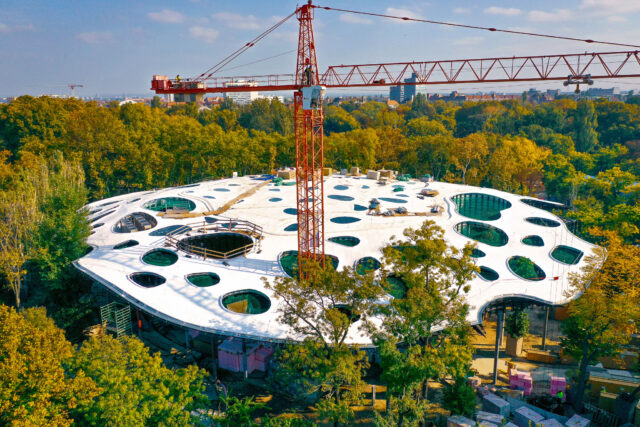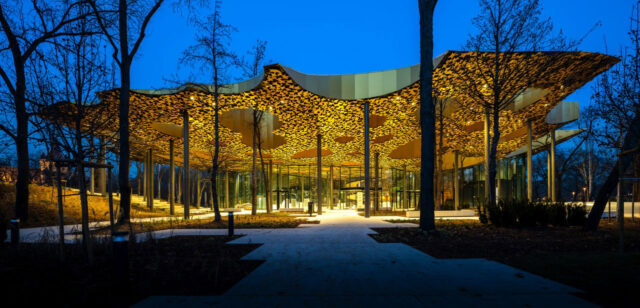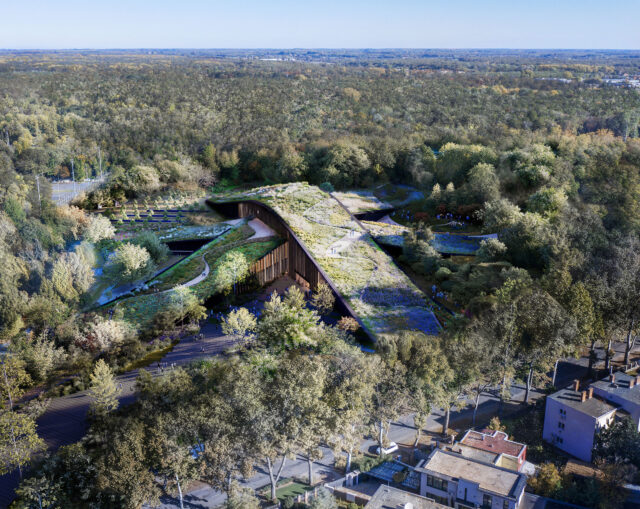
SHARE 藤本壮介による、ハンガリー・ブダペストの音楽施設「ハンガリー音楽の家(House of Hungarian Music)」が竣工間近。音の振動を視覚的に表現した波から着想を得た浮屋根が公園の森の中に浮かぶ


藤本壮介が設計して建設が進められている、ハンガリー・ブダペストの音楽施設「ハンガリー音楽の家(House of Hungarian Music)」竣工間近で、その様子を伝える写真や動画が公開されました。音の振動を視覚的に表現した波から着想を得た浮屋根が公園の森の中に浮かぶ建築です。竣工は2021年末を予定。アーキテクチャーフォトでは2021年1月時点での現場の様子も特集記事として紹介していました。
以下は、リリーステキストの抜粋・翻訳
日本人建築家、藤本壮介氏が設計した「ハンガリー音楽の家」は、ヨーロッパ最大の都市文化開発プログラムである「リゲ・ブダペスト・プロジェクト」の一環として、ハンガリーの首都に建設されています。この建物は、有機的に起伏した屋根構造を持ち、広いガラス壁と穴の開いたキャノピーが特徴的で、人目を引きます。同時に、その優美さと透明な表面のおかげで、建物を取り囲む公園と調和しています。新施設は、世界初の複合型音楽イニシエーション施設として運営され、音楽の歴史に関するインタラクティブな展示、コンサート、エキサイティングな音楽教育ワークショップなどの幅広いイベントを通じて、来場者に無数の音楽体験を提供します。
リゲ・ブダペスト・プロジェクトは、現在ヨーロッパで最も重要な文化開発であり、ハンガリー最大規模の公園やランドスケープ・アーキテクチャー・プロジェクトと、ミレニアムの時代以来の規模の施設の開発を組み合わせたものです。リゲ・ブダペスト・プロジェクトの一環である「ハンガリー音楽の家」は、ブダペストで最も重要な観光名所である英雄広場の近く、かつて取り壊されたオフィスビルの跡地に建設されています。設計者である藤本壮介氏は、ユニークで刺激的かつ有機的な建物を作り上げました。彼のデザインは、国際コンペに提出された168のプロジェクトの中から、ハンガリーと国際的な審査員によって選ばれました。
藤本壮介氏は、「ハンガリー音楽の家」の国際コンペに参加するにあたり、自然環境と建築環境の境界が取り払われ、音の性質と自然の音の間に調和が生まれるようなプロジェクトを思い描きました。デザインの特徴である浮屋根は、音の振動を視覚的に表現した「波」から着想を得ています。藤本は、開放性と透明性のスピリットに基づき、建物の側壁をガラスで構成し、屋根のパンチング構造を光の井戸で連結することで、樹木の葉のように建物内部に光を取り込むようにしました。また、ブダペストの有名な分離派建築であるリスト・アカデミーや、国際的に有名なハンガリーの音楽と音楽教育の伝統からもインスピレーションを受けました。
藤本壮介氏は自身のヴィジョンをこう語ります。
「世界初の公共公園のひとつであるブダペスト公園で仕事をすることは、信じられないほど刺激的なことです。建物を作るだけでなく、公園での経験を建物の中に持ち込むことができたので、建物を設計する作業は特にエキサイティングでした リゲ・ブダペスト・プロジェクト、そしてその中のハンガリー音楽の家は、まさに象徴的な開発プロジェクトであり、緑地と建築物の間に卓越した調和を生み出すことに成功したことから、将来の都市開発者の手本となるかもしれません。」
藤本氏のヴィジョンを実現するための特徴の一つは、建物に、優美さ、透明性、個性を与えるガラス壁です。ファサードのガラス壁は94枚の特注断熱パネルで構成されており、建物の一部では12メートル近い高さになっています。
もうひとつの象徴的なデザインは、有機的な屋根構造です。藤本氏は、音の波の形からインスピレーションを得て、特殊なフローティングルーフを開発しました。厚さの異なるキャノピーが遊び心を持って起伏することで、建物が周囲の環境に調和しています。
藤本壮介氏は語ります。
「『ハンガリー音楽の家』の壮大で紛れもない外観を支えているのは、ハンガリーでは前例のないデザインとエンジニアリングのソリューションの数々です。屋根の構造には直角がなく、同じ要素はほとんどありません。さらに、革新的なソリューションのひとつであるライトウェル(光の井戸)は、この開口部に設置されており、光を最下層まで届けることで、内部を照らし、独特の雰囲気を醸し出しています。」
「ハンガリー音楽の家」の建設にあたっては、環境への配慮を最重要視しました。再生可能エネルギーや特殊な冷暖房システムの使用は、プロジェクトの計画段階から特に重要視されていました。再生可能な地熱エネルギーを供給するために、120台のヒートポンプが、建物に隣接するナギレツと呼ばれるシティパークの小さなエリアの地下100メートルに設置されました。もうひとつの経済的で非常に革新的なソリューションは、遠隔冷房システムです。「ハンガリー音楽の家」の建物とその構造は、世界有数の国際的な持続可能性評価手法であるBREEAMによって、環境の観点から模範的であると評価されました。
以下の写真はクリックで拡大します



こちは計画案の動画。
以下は、リリーステキストです。
Sou Fujimoto’s award-winning House of Hungarian Music is structurally ready
One of the most exciting contemporary buildings in the world is near to completion
The House of Hungarian Music, designed by Japanese starchitect Sou Fujimoto, is being built in the Hungarian capital as part of the Liget Budapest Project, Europe’s largest urban cultural development programme. The building cannot but draw the eye with its organically undulating roof structure distinguished by its extensive glass walls and its canopy perforated with holes. At the same time, thanks to its gracefulness and transparent surfaces, it harmoniously blends in with the park that embraces it. The new institution will operate as the world’s first facility of complex musical initiation bringing countless musical experiences to visitors through its wide range of events: interactive exhibitions on musical history, concerts and exciting music education workshops. In 2019 the building was selected as Europe’s best public building at the International Property Awards, while at the 2020 Music Cities Award it won the title of the World’s Best Use of Music in Property Development. The building has been completed structurally and it is anticipated to open its doors to the public at the end of 2021. CNN and the World Architecture Community have chosen the House of Hungarian Music as one of the most anticipated buildings in 2021, alongside works by starchitects such as Zaha Hadid, Rem Koolhaas and Renzo Piano.
The Liget Budapest Project is currently Europe’s most significant cultural development, which combines Hungary’s largest-scale park and landscape architecture project with the development of institutions not seen on a scale since the days of the millennium. The House of Hungarian Music, a development forming part of the Liget Budapest Project is being constructed near Heroes’ Square, one of Budapest’s most important attractions, on the site of a formerly demolished office block. The designer, Sou Fujimoto, has created a unique, inspiring and organic building. His design was selected by Hungarian and international jurors from among 168 projects submitted to an international competition.
Sou Fujimoto’s vision
When entering the international competition for the House of Hungarian Music, Fujimoto envisioned a project in which the boundary between the natural and the built environments is dissolved, and harmony is struck between the nature of sound and the sounds of nature. The signature feature of the design, the floating roof, was inspired by the visual representation of the vibration of sound: the wave. In the spirit of openness and transparency, Fujimoto designed the side walls of the building to be made of glass and the perforated structure of the roof articulated by lightwells to let light into the interior of the building much like the foliage of trees. He also drew inspiration from the famed Secessionist building of the Liszt Academy in Budapest and, not least, by the internationally renowned tradition of Hungarian music and music education.
“It is incredibly inspiring to work in one of the world’s first public parks, and the task of designing the building was especially exciting since we not only created an edifice but also brought the park experience into the building. The Liget Budapest Project, and within it the House of Hungarian Music, are a truly emblematic development project, which might serve as an example for future urban developers since it managed to create exceptional harmony between the green and the built-up environments.” – noted Sou Fujimoto about his vision.
Unique architectural solutions
One of the features facilitating the implementation of Fujimoto’s vision is the building’s glass wall, which lends it gracefulness, transparency and individuality. The unique appearance of the House of Hungarian Music is coupled with special engineering solutions: the glass wall of the facade consists of 94 custom-manufactured heat-insulated panels, which are close to 12 metres high in some parts of the building.
Another iconic feature of the design is its organic roof structure: Fujimoto’s special floating roof was inspired by the form of soundwaves. The playfully undulating canopy of varying thickness stays below the level of the foliage, ensuring that the building harmoniously blends in with the environment.
“Underpinning the spectacular and unmistakable sight of the House of Hungarian Music is a host of design and engineering solutions unprecedented in Hungary. There are no right angles in the roof structure, almost no two elements that are the same. It is all unique and the surface is punctured by close to 100 individually designed holes for the trees of the park to emerge through; moreover, one of the innovative solutions was also installed in these openings: the lightwells begin here, which channel the light right down to the lowest levels, thus helping to illuminate the interiors and create a unique ambiance.” – said Sou Fujimoto.
Environmental awareness and sustainability
Environmental awareness has been of paramount importance throughout the construction of the House of Hungarian Music. Special emphasis was accorded to renewable energy and the use of special heating and cooling systems already in the planning phase of the project. One hundred and twenty heat pumps were installed 100 metres underground in a small area of the City Park, called Nagyrét, next to the building to provide renewable geothermic energy. Another economical and extraordinarily innovative solution is the telecooling system. The building of the House of Hungarian Music as well as its construction were rated as exemplary from an environmental perspective by BREEAM, the world’s leading international sustainability assessment method.
Recognition from both the architectural and the music profession
The remarkable building of the House of Hungarian Music drew the attention of the international architectural community. In 2019 it was selected as the best public service architecture project in Europe at the prestigious International Property Awards competition in London, one of the largest-scale, most prestigious and widely acclaimed recognitions of the property sector launched 27 years ago. Then, in 2020, it won the award for the world’s best development with a musical theme in the “Best Use Of Music In Property Development/Real Estate” category at the American Music Cities Awards, a prominent series of events organised by the most important international players in the music industry with the aim of fostering the economic, social and cultural development of cities through the medium of music. The best initiatives in music were evaluated in nine categories. The House of Hungarian Music was chosen among the top three by a jury of ten international experts as the only European project and won the main prize beating two US developments.
The content of the House of Hungarian Music
The unique appearance of the House of Hungarian Music is matched by a special interior structure. The institution’s complex musical profile and programmes are reflected by the three-level layout: the level below ground will be home to exhibitions – permanent and temporary – and a remarkable sound dome; the park level is devoted to the performing arts: live events will be held in the concert halls and the open-air stage alike, while the terrace near the City Park Lake will be a place for recreation; while the level above it will house an archive of Hungarian pop music, serving as a source of quiet immersion in music and education, and the workshops to be held in the music education rooms will initiate young visitors into the complex musical experience awaiting them at the exhibitions and performances.
The House of Hungarian Music will take this rich musical tradition closer to domestic and foreign visitors with its interactive exhibitions utilising 21st-century technology, music education workshops, musical events and those themed on music as well as with its open-air concerts evoking the atmosphere of the musical pavilions of the past. A new, long-awaited institution will be established in the City Park, whose mission is to take music – perhaps the branch of Hungarian art that is best known and most recognized in the world – to the general public.
“The House of Hungarian Music will be unique in that it will accommodate the triad of exhibitions, live music and music education in one venue. It will guide visitors through the world of music thanks to a diverse range of events: the underground level of the building will be devoted to exhibitions, including a permanent show on the history of music, which will take visitors along a journey through the development of music using interactive and spectacular technical solutions.” – said András Batta, the director of the House of Hungarian Music and former president of the Liszt Academy.
On the level below ground, a memorable experience will be provided not only by the temporary exhibitions but also by the sound dome, a special hemispherical cupola in which diverse ‘sound spaces’ will be created with unique audio and projection technologies. The ground floor will house concert halls and an open-air stage, where fledgling musical formations will be given an opportunity to show their talent besides established performers. The first floor will be the venue for music education and a digital library. It will be home to an experience-based information centre with its comprehensive range of events for school groups and groups of children making it indispensable in the education of both classical and popular music.
“The House of Hungarian Music will also take on an educational role with the development of the music education concept and events being the task of a separate team of experts. Something is turned into an experience if people can make what they can see, hear, touch and feel their own, if they can store all this and recall it later. It is therefore especially important that everything that visitors encounter at our exhibitions can be stored as real experiences among their memories.” – stressed András Batta.







